
Puzzle Laboratory Guide to Hexominoes
compiled by Michael Keller

A
B C D
F f G
H I J K L

M
m N n O
P p Q
R S
T t

U u
V W
w X x
Y y Z z
The 35 Hexominoes
Special thanks are due for contributions to this compilation
to: Andrew Clarke, Roel Huisman, George P. Jelliss, Henri Picciotto, Michael Reid,
George Sicherman, Teun Spaans, and Anneke Treep.
The hexominoes (order-6 polyominoes) are a set of geometric shapes made
up of six squares joined edge-to-edge in every possible
shape. Discounting rotations and reflections, there are 35
shapes as shown above. We will use a single-letter notation,
using a selection of upper and lower-case letters, to refer to the
pieces throughout this booklet. {I have reversed the designations
of N and n from the original, as I wanted to follow the principle that,
in pairs using the same letter, a capital letter denotes a symmetric
piece and the corresponding lower case letter an asymmetric one, where
possible, as with TUYZ.} Before Solomon W. Golomb coined
the term polyominoes in 1953, they had been studied largely in the
pages of the Problem
Fairy Chess Supplement (renamed Fairy Chess Review in 1936)
under the title Dissections. These constructions were mostly
published in a condensed notation, rather than in full diagram form
(which would have been prohibitively expensive in the 1930s and
1940s), and were little-known until G.P. Jelliss painstakingly decoded
them and published them in diagram form in his journal Chessics (now available online).
In fact, the first dissection problem in the PFCS was by Herbert D.
Benjamin in 1934, who correctly counted what are now called the 35
hexominoes, and proposed, in a Christmas puzzle with a 20-shilling
prize, trying to form a 14x15 rectangle. A year later, F. Kadner
gave the now-familiar proof (using checkerboarding) that perfect
rectangles cannot be formed with the full set, and was awarded the
prize. In 1937, Benjamin produced the first full-set
construction without holes, the isosceles right triangle (problem [89]
here), and G. Fuhlendorf produced a series of eleven 17x12 rectangles,
each omitting one of the 11 unequal rectangles. In 1946, Frans
Hansson sextuplicated each of the 11 unequals, using a full set plus an
extra copy of the piece being multiplied. In 1947, he solved the
1-3-5 Problem (problem [95] here) for each of the 11 unequals, and
finally in 1952, Hansson solved the problem of making 5 identical
layers of 7 pieces with the full set (The Layer Problem, [82]
here). There is no record of the reverse problem, 7 layers of 5,
having been solved in FCR. Many other early
constructions can be found in Jelliss'
page on hexominoes. Hexominoes were first
mentioned by name in Golomb's 1965 book Polyominoes.
But even more than half a century later, they are very much
overshadowed by their
smaller cousins, the pentominoes. This booklet is an attempt to
show the scope of puzzles possible with the much larger set.
The majority of this booklet was originally published in
WGR6 (September 1986) as WGR
Special Supplement Number 1: New and Not-So-New Hexomino
Puzzles, at the time the largest collection of hexomino problems ever
published. It has been supplemented here by additional material
from other issues of WGR. This supplement contains over 100
problems, most of them either new ones or new
variations of older ones. The nontrivial problems presented here
are labeled with numbers enclosed in square brackets [11].
Solutions to selected problems are included. However, many of
these problems are open-ended (the best solution is not known).
Nearly all of the
solutions here were found without computer assistance, except where stated, and for those
few puzzles for which the total number of solutions is enumerated.
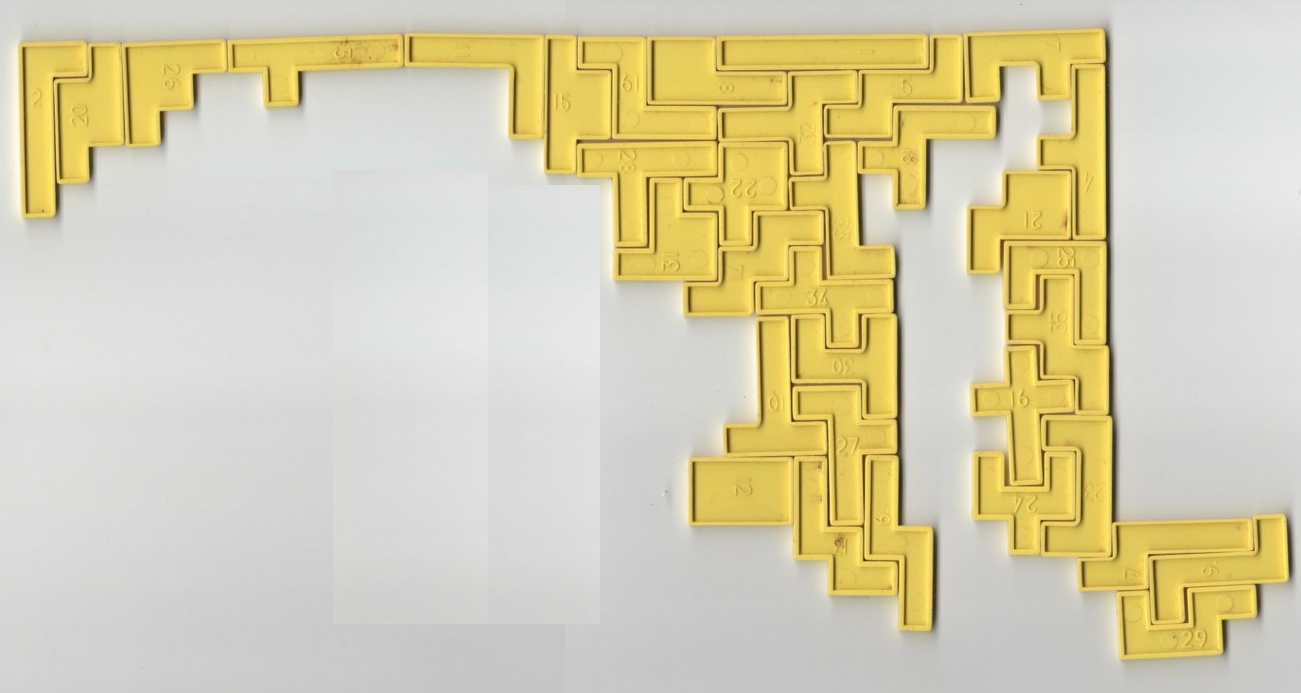
I was first introduced to hexominoes through Multipuzzle, a set of 48
hexomino puzzles published by Spear's, an English game and puzzle
manufacturer.
BoardGameGeek says the first edition of Multipuzzle came out
in 1960 (my copy of the
booklet is undated); though it is out of print, copies can be found
on eBay and other sites. Multipuzzle
comes with 42
plastic hexominoes (7 are duplicates: IMmPUuX) and a
plastic tray 6x10 squares in size. Each puzzle consists of a list
of eight, nine, or ten pieces which are to be formed into a 6x8,
6x9, or 6x10 rectangle (one or two I hexominoes are used to mark off a
6x8 or 6x9 area within the tray). Solutions are provided for all
puzzles. Of course, the pieces can be used for other hexomino
puzzles as well:
I found some of the older solutions in this booklet using
Multipuzzle. Shown above is a stylized map of my home state of
Maryland, illustrated using the standard set of 35 pieces from
Multipuzzle (using my over-half-a-century-old set).
A few comments on solving hexomino problems may be helpful. The
most useful rule of thumb is to place the difficult pieces as soon as
possible and save the easy pieces as long as possible. Here is a
rough ordering of the hexominoes (from hardest to easiest to handle,
and divided into five groups) which will be useful in most problems:
KXwmZUuT JARFzf tHCGNWS VIYnLy DOpPxMQB.
In many of the solutions herein, you can see that the more useful
pieces were saved until last (e.g. I found a solution to [70] moving
generally left to right.)
An important concept to understand is checkerboarding. Imagine a
figure to be solved being checkered black and white, and the hexominoes
also checkered black and white. Twenty-four of the hexominoes, called
equal hexominoes, cover 3 black squares and 3 white squares. The
remaining eleven, called unequal, cover 4 black and 2 white squares, or
vice versa. Therefore any figure which is to be covered by a full
set of hexominoes cannot have an equal number of black and white
squares; there must be
two extra squares (or two plus a multiple of four) of one color. For example,
checkerboard the figure shown for problem [88], and you
will count 104 squares of one color and 106 of the other color.
So no perfect rectangle can be covered by the full set of hexominoes, and a
subset of the 35 hexominoes can only form a perfect rectangle if it has
an even number of the unequal hexominoes. The
smallest rectangle that contains the full set is 4x53, with two missing
squares of the same color (see below):

When solving figures with a large difference between black and white
squares, care must be taken. For example, figure [89], the
Pentagon, has a difference of 18 squares. This means that 10 of
the 11 unequal hexominoes must cover four squares of the majority
color, in this case, the squares of the same color as the diagonal
border (10*4+2=42, 10*2+4=24). Below is a figure with the maximum possible color difference of 22.
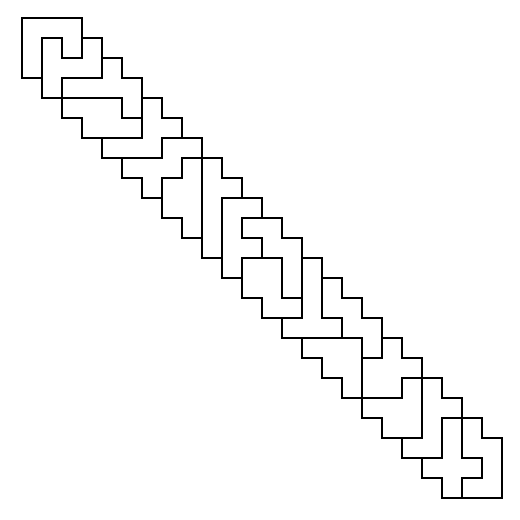
For some of the subsets in section 1, a rectangle which is not perfect
can be determined to be the best possible if a perfect rectangle is
ruled out by checkerboarding and the intervening areas are ruled out by
lack of suitable factors. For example, in subset [34], a
rectangle of area 63 is the smallest possible. 60 is ruled out by
checkerboarding, 61 is prime, and 62 has only 2 and 31 as prime
factors (too narrow for most pieces).
When trying to make long narrow rectangles, the length of the border is
important. If the pieces involved do not have enough border
squares, the rectangle will be impossible to make. Generally the
number of border squares needed is twice the length of the long
side. The short ends are unimportant, as pieces placed at the
corners can make up the extra length. Perfect rectangles of width
3 are impossible with a full set of 35 hexominoes, as certain pieces
(AFfHJQRStWXxz) divide the strip into two groups of squares which are
not multiples of six. The following list gives the usual maximum
number of border squares for each piece.
piece
A B C D F f G H I J K L M m N n O P p Q R S T t U u V W w X x Y y Z z
border
2 3 4 3 2 3 3 3 6 2 1 5 3 2 3 4 3 4 4 2 1 2 3 4 4 3 4 2 2 1 2 5 5 2 3
Contest Number Four: Hexomino Double
Challenge (WGR4, February 1985, p.16)
[1] Four hexominoes may be assembled into a
5x5 square with a hole in it. The hole may occur in any of
six essentially different locations, as shown in the diagram below.
(All other locations are rotations/reflections of the six basic squares
below.) Use 24 different hexominoes out of the set of 35 to make six
simultaneous 5x5 squares, each square having the hole in a different
position.

[2] The second part of the contest is to
solve the six squares above using as few different hexominoes as
possible. In this part of the contest a hexomino may be used in
as many different squares as possible (but not twice in the same
square). Below is a sample entry, which uses a total of 10
different hexominoes (AfGKLMPUWY). It should be very easy
to beat
this. [Several solvers, including me, managed to get it down to
five, which is the smallest possible because of parity. See
my solution with LMQUW in the Appendix.]

Variations suggested in the contest wrap-up in WGR5:
[3] Make four 7x7 squares with holes in different positions, using 32
pieces.

[4] Make as many 4x5 rectangles as possible with pairs of holes in
different positions. My best was 9, using 27 pieces, with two
internal holes. Roel Huisman improved this to 10, using 30
pieces, with no internal holes and all ten shapes sharing a hole in the
upper left corner.

Hexomino Multiplication Problems
(originally More
Hexomino Problems, problems 1-6 on page 8 of WGR5)
For those who enjoyed working with hexominoes (currently my favorite
puzzle), here are some more problems to solve. A multiplication
is a polyform construction in which an enlarged replica of a small
figure (usually one or two pieces) is constructed using a selection of
the remaining pieces. Each single square is replaced by an NxN
square. For example, a duplication of the Q hexomino and a
triplication of the w hexomino are shown
below. Note that the piece being multiplied should not be used in
the larger figure, and when doing simultaneous multiplications, no
piece should be used twice, including those being multiplied (the
exception to this is that a piece being sextupled should be used twice
more in the larger figure, to make 37 pieces in all).
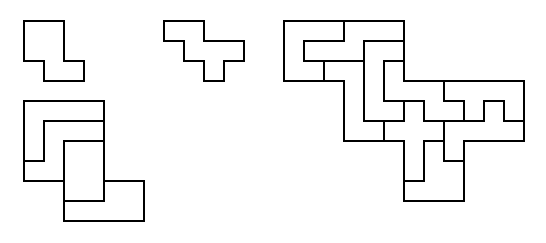
Two of the pentomino problems in Sivy
Farhi's Pentominoes
deal with multiplications. The first is the double-double
problem: Make a shape with two pentominoes, make the same shape
again with two more pentominoes, and finally make a double sized
version of the same shape with the remaining eight pentominoes.
The second is the simultaneous triplication problem (solved by R.
W. M. Dowler in 1980): Construct a triple sized replica of each
of the twelve pentominoes, using nine complete sets of
pentominoes (108 pieces). Do not use any pentomino in its own
triplication. Farhi gives five solutions to the first, as well as
Dowler's solution to the second. Simple duplications (four
pieces), triplications (nine pieces), quadruplications (sixteen
pieces), and quintuplications (twenty-five pieces) of single
pieces are possible with the hexominoes, but all but the last are
fairly easy, and quintuplications are only moderate in
difficulty. More challenging puzzles can be devised by doing
simultaneous multiplications. Remember that the piece or pieces
being replicated cannot be used to
duplicate other pieces (except when doing a sextuplication using a set
plus one repeated piece). These puzzles are listed in the order
of
the total number of pieces required (a very rough estimate of
difficulty).
[5] Triple Triple (total 24 pieces): select two pieces and form them
into a two piece shape, then make the same shape with two other pairs
of pieces. Finally do a triplication of the same two-piece shape
using eighteen of the remaining twenty-nine pieces.
[6] Quintuple duplication (total 25 pieces): duplicate five
hexominoes at the same time using twenty of the remaining thirty
pieces. [In the original article, I said I suspected that
it is impossible to duplicate six (30) or
seven (35) pieces. George Sicherman has confirmed by
computer search that this is the case: there are no solvable sets of
six (30) pieces,
obviously making seven impossible too.]
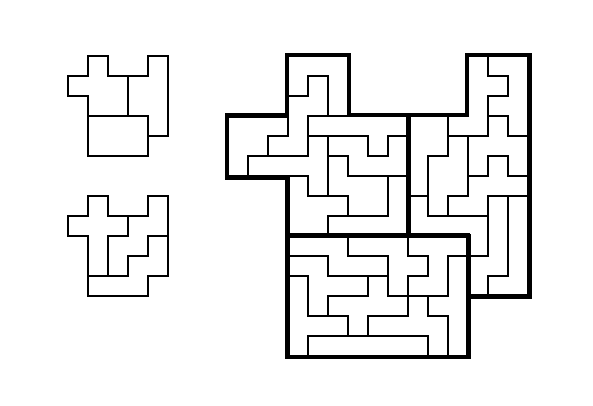
[7] Triple triplication (total 30 pieces): select three hexominoes
and then triplicate all three at the same time using twenty-seven of
the remaining thirty-two pieces. (In WGR9 I extended this
slightly, as seen above, by using three of the other pieces and making
the same shape twice singly, then triplicated, for a total of 33
pieces).
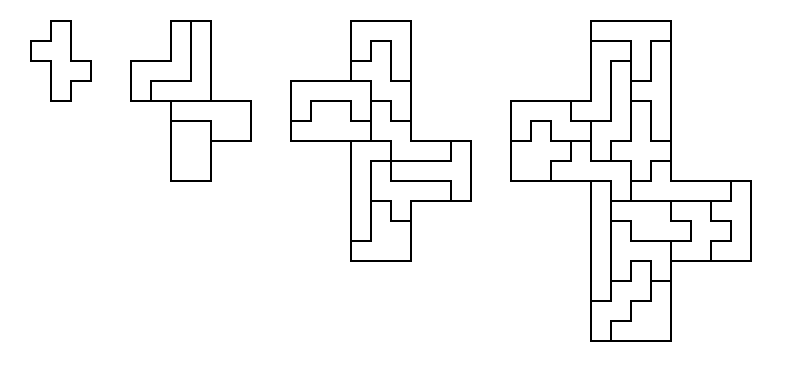
[8] One-Two-Three-Four (total 30 pieces): select a hexomino and
duplicate, triplicate, and quadruplicate it, using no piece more than
once. This problem was posed by Andrew Clarke in the Journal of
Recreational Mathematics (13:1), for a mixed set of the 25
polyominoes of perimeter 12. It
is well suited to the hexominoes. [In the original article, we asked whether One-Two-Three-Four-Five-Six
is possible using 91 of the 105 heptominoes. It is; Roel Huisman sent an example, shown below:)

[9] Double Double Triple (total 33 pieces): select three pieces and
form them into a three piece shape, then make the same shape with two
other triplets of pieces. Duplicate the three-piece shape using
twelve of the remaining twenty-six pieces, and finally duplicate the
three-piece shape again using twelve of the remaining fourteen
pieces. [The appendix shows my solution where all of the
three-piece shapes are composed of unequal pieces.]
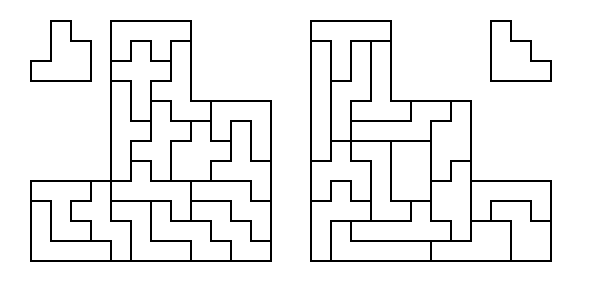
[10] Double quadruplication (total 34 pieces): select two hexominoes
and quadruplicate both at the same time using
thirty-two of the remaining thirty-three pieces.
Subset puzzles
Some puzzlers feel that the full set of 35 hexominoes has too many
pieces to make a good puzzle. It should be obvious from this
booklet that I do not share this view, but there have been many puzzles
derived from a subset of the hexominoes, and there are certainly
interesting problems to be found among them.
H.D. Benjamin was perhaps the first to make constructions with subsets
of the hexominoes. His problem 4143 in the December 1939 Fairy Chess Review
discards the 8 pieces which fit into a 3x3 square, leaving 27 pieces
(CDFfGIJKLmNnPpRSTtUVWwXYyZz). He uses these to construct a
perfect 6x27 rectangle (Walter Stead later did 9x18). T.R.
Dawson constructed hollow rectangles with the 20 asymmetric pieces
(problem 7593, FCR, April 1948). Frans Hansson used the 24
equal hexominoes to construct a quintuplicated version of X with a hole
in the shape of X placed symmetrically (similar to the full-set
sextuplication below in [99]), This was problem 10,201 in August
1955, and was followed later by similar constructions for other
unequals. In the June 1956 issue (problems 10,451
through 10,453), Walter Stead defined the 13 line pieces (set [40] below) and the 14 tree
pieces (ACFfHJKRTtwXYy), and made perfect 6x13 and 6x14 rectangles
respectively, as well as 9x18 with the combined set of 27 (which is the
same as set [32] below).
Volume 14, Number 2 of the Journal
of Recreational Mathematics included
a problem (number 1064) by Harry L. Nelson : There are 11 hexominoes
(FJKmNRSTwXZ) which can be folded into a cube. What is the
smallest rectangle into which they can all be packed? Nelson and
Richard I. Hess each produced a 7x11 rectangle: this may or may not
be the best solution. In any case, we can produce other subsets
of the 35 hexominoes and ask the same question. Let us
start by looking at the hexominoes which contain a 2x2 square.
There are eight of these (BDMOPpQx), all of which can be produced by
adding a square to a P-pentomino. We may thus call these
P-derivatives [15]. Since there are three unequal hexominoes in this
set, a rectangle of 6x8 or other dimensions is impossible. Thus
the smallest rectangle must have an area of at least 49 squares.
Is a 7x7 square (with one hole) possible? The answer is yes, and there
are four locations possible for the hole, as determined by parity
constraints. All four locations (below) are solvable (a
sample solution for the second location, the easiest of the four, is
also shown).

11
solutions
22
solutions
11
solutions
5 solutions
The four 7x7 squares
possible with the P-derivatives
Eleven other similar subsets can be derived, one from each of the other
11 pentominoes. The pieces and the smallest rectangles possible
for each subset are listed below. (The trivial case of Xx is not
numbered). Michael Reid and Robin King found improvements for
several of my original solutions. George Sicherman
recently analyzed the problem in Tables 1-4 by computer, finding
several more improvements and proving all of the other results
optimal. Unusually for polyomino problems, a few of these
rectangles have unique solutions (marked by underlines), disregarding
reflections and rotations: [12], [19], [21], [22], and [37].
Table 1: Minimum Rectangles for Pentomino-Derivative Subsets
Pentomino Derivatives Rectangles
[11]
F
ABFfJKQwx
7x9
[12]
I
ILYy
2x13
Robin King
[13]
L
CFLnPRTUVyZ
6x11 Michael Reid
[14]
N
DfGJNnPSWw
7x9
[15]
P
BDMOPpQx
7x7
[16]
T
BHJTtX
6x7
[17]
U
ACGHOu
3x13
[18]
V
fMtuVz
4x10, 5x8
[19]
W
MmQWw
3x11
X
Xx
4x5
[20]
Y
CFKPpRtXYy
7x9
[21]
Z
HQRSz
5x7 Robin King
If you try dividing a hexomino into two trominoes, you will get one of
four results: two straight trominoes (e.g. n), two right-angle
trominoes (e.g. m), one of each (e.g. L), or you cannot divide it into
two trominoes (e.g. A). In two cases (D and O) you get either two
straight or two right, depending on how you choose to divide it.
We can therefore produce four subsets, which I call
di-orthotrominoes, di-rectotrominoes, di-heterotrominoes and
non-bisectable hexominoes. We ask the same question: What is the
smallest rectangle which contains every member of a given
subset?
Table 2: Minimum Rectangles for Tromino Subsets
Di-Tromino Subset
Pieces
Rectangles
[22]
di-orthotrominoes
DINTV
3x11
George Sicherman
[23]
di-rectotrominoes CDGKmOpQRSUwxZ 4x22, 8x11
[24]
di-heterotrominoes
BfHLMnPuWyz 6x11
Sergio Stanzani
[25]
non-bisectable
AFJtXY
6x7
[26] tridominoes ABFGIJLmNnO
6x23
PpQStUuVWYZz
Instead of dividing hexominoes into two trominoes, what about dividing
them into three dominoes? This is possible with all but one of the
equal hexominoes, K being the exception. The remaining 23 tridominoes
can be made into a 6x23 rectangle [26].
We can also divide each hexomino into a domino and a tetromino.
There are five tetrominoes, so we can generate five more subsets.
Note that K cannot be divided in this manner, but many of the
hexominoes can be divided in more than one way, and thus fall into more
than one group. The S3 group is the same as the unequal (4-2)
hexominoes.
Table 3: Minimum Rectangles for Tetromino Subsets
Domino Plus Subset
Pieces
Rectangles
[27]
S1 tetromino (I)
ILnPptV
4x11
[28]
S2 tetromino (L) BFGJLNOPQStUuVWYZz 4x27, 6x18,
9x12
[29]
S3 tetromino (T)
CDfHMRTwXxy 7x10, 5x14
[30]
S4 tetromino (N)
ABFGmnpQSW
7x9
S8 tetromino (O)
OPQ
4x5
Andrew Clarke's article Isometric Polyominoes in The Journal of
Recreational Mathematics (13:1) discusses the perimeters (border
lengths) of various sets of polyominoes. The hexominoes fall into
three groups: (1) O alone has perimeter 10, (2) seven hexominoes have
perimeter 12 (the remaining P-derivatives), (3) the remaining 27 have
perimeter 14. The latter two groups (listed below) make useful
subsets (O forming a trivial 2x3 rectangle). We can also classify
the hexominoes by number of sides. I and O are rectangles (4
sides); L, P, and V are hexagons (6 sides); 15 hexominoes are octagons
(8 sides); 10 are decagons (10 sides); the remaining five are
dodecagons (12 sides). The latter three groups are listed below
(IO make a trivial 3x6 rectangle, and LPV make another easy 3x6
rectangle, this one perfect). Some other possible subsets are
also listed below. The single path subset consists of those
pieces which do not contain an S3 tetromino. The S1 second
derivatives are those pieces which consist of an S1 tetromino and two
monominoes in any arrangement (this includes all of the pieces of
[27]). The N-less subset consists of those pieces which do not
contain an S4 tetromino. Number [36] is
a well-known problem: 9x16, 8x18, and 6x24 are also possible.
Michael Reid sent a short proof that 4x36 is impossible.
Table 4: Minimum Rectangles for other subsets
Description
Pieces
Rectangles
[31]
Perimeter
12
BDMPpQx
4x11
[32]
Perimeter
14
ACFfGHIJKLmNnRSTtUuVWwXYyZz 6x27,
9x18 Walter Stead
[33]
Octagons
BDMNnpQTtUuYyZz
5x18, 6x15,
9x10
[34]
Decagons
CFfGHJRSWx
7x9
[35]
Dodecagons
AKmwX
6x7
[36]
equal
(3-3)
ABFGIJKLmNnOPpQStUuVWYZz
12x12 etc.
[37]
symmetric
AIMOpTUXxY
4x15
David Bird
[38]
rotational
DKmNZ
5x8
[39]
symmetric or rotational
ADIKMOmNpTUXxyZ
6x15, 9x10 George Sicherman
[40]
single
path
GILmNnSUuVWZz
6x13 Walter Stead [FCR
June 1956, number 10,451]
[41]
S1 second derivatives
CFIKLnPpRTtUVXYyZ
4x26,
8x13
[42]
N-less
CHILRTtUuVXYyZz
5x18,
9x10, 6x15 Michael Reid
Finding minimum rectangles is only one problem that can be solved with
subsets. Other shapes can be made with some or all of the pieces
in a subset. Try making triplications with subsets having ten or
more pieces, or quadruplications with subsets having seventeen or more
pieces.
Stewart Coffin's Cornucopia Puzzle
is a clever idea built
on the idea of hexomino subsets. It consists of a set of 10
pieces selected from the 17 hexominoes with no symmetry which do not
contain a 2x2 square (i.e. CFfGHJLnRStuVWwyz). Each set of 10 is
used to solve an 8x8 square with four holes in rotational symmetry in
at least one position, and three of the usual rectangles (4x15, 5x12,
and 6x10) solvable with pentominoes. [The full set of 17
pieces can also form a 17x6 rectangle.] 100 one-of-a-kind
Cornucopia puzzles made in wood were sold in 1985; each had a unique
set of pieces. Cornucopia is described in more detail in
two of the
sources listed in the bibliography (Coffin and Dewdney).
Superset puzzles
We've already seen that many subsets of the hexominoes can form
perfect rectangles. Perfect rectangles can also be made in
various ways by adding pieces to the set. Wade E.
Philpott's article
in the Journal of
Recreational Mathematics (10:1) lists
two: add (or subtract as seen above) an odd number of unequal hexominoes, or use a
double set of 70 hexominoes. Richard Laatsch's
later article (JRM 13:1) gives
a third: add
two trominoes (producing an effect somewhat similar to adding one
unequal hexomino). Rectangles
of 4x54, 6x36, 8x27, 9x24, and 12x18 are possible with the set of
hexominoes plus trominoes: 3x72 is not. Of these, I think 8x27
has a certain numerical elegance: 216 is the cube of 6, and 8x27
divides it into the product of two cubes.
In addition to the trominoes, other lower order polyomino sets can be
added to the hexominoes to make a set which can be made into a
rectangle. For example, hexominoes plus pentominoes make a 47
piece set covering 270 squares: this makes a number of different
rectangles shown in the table below. (This was first done
in Fairy Chess Review by H.D. Benjamin and others). In
fact, every combination
of the three lower order sets added to the hexominoes makes at least
one rectangle. I have added one additional group, consisting of
all of the lower order polyominoes, including the single monomino and
domino. This is in the spirit of Hans Havermann's 5x211 problem
using the seven lower orders. (It is possible to solve
Havermann's problem by making a 5x153 rectangle made of orders 7, 3, 2,
and 1 to the 5x58 rectangle made of orders 6, 5, and 4).
Table 5: Rectangles made by combining complete sets of hexominoes
with complete polyomino sets of other orders
Orders Pieces Total
area Rectangles possible
[43]
6 5
47
270 5x54, 6x45, 9x30,
10x27, 15x18
[44]
6 4
40
230 5x46, 10x23
[45]
6 3
37
216 4x54, 6x36, 8x27,
9x24, 12x18
[46]
6 5 4
52
290 5x58, 10x29
[47]
6 5 3
49
276 4x69, 6x46, 12x23
[48]
6 4 3
42
236 4x59
[49]
6 5 4 3 54
296 4x74, 8x37
[50]
6 5 4 3 2 1 56
299 13x23
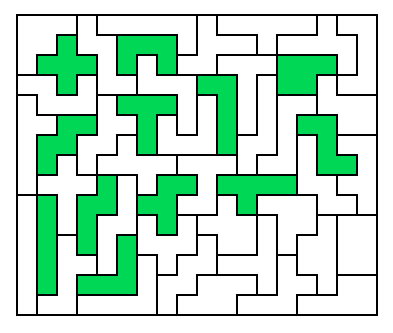
[43] 15x18 Hexomino Rectangle
with Enclosed
Pentomino Holes
One-Sided Hexominoes
Still another alteration to the hexominoes which makes rectangles
possible is the rotational or one-sided
hexominoes [51]. In this set, each hexomino without bilateral
symmetry is
replaced by two mirror images, which can be rotated but not turned
over. To construct such a set, glue two large sheets of paper or
cardboard of different colors (say red and white) together to make a
sheet with one side red and the other side white. Cut out one
full set of hexominoes with the red side face up, and another set,
using an identical pattern, with the red side face down. Now put
aside one copy of each bilaterally symmetric hexomino
(AIMOpTUXxY). Don't
throw them away, as they can be used for double set problems. You
will have 60 pieces left. You must use each piece with the red
side face up. David Klarner discusses the one-sided pentominoes
(18 pieces) in an anthology he edited, The Mathematical Gardner.
Solomon Golomb posed a problem with the one-sided pentominoes in his
book Polyominoes. I do not know whether the one-sided hexominoes
have been studied before. There are 42 equal one-sided
hexominoes (6 symmetric and 18 mirror-image pairs) and 18 unequal
one-sided hexominoes (4 symmetric and 7 mirror-image
pairs). This eliminates parity problems, so a number of
rectangles are possible. A 3x120 rectangle is impossible, as many
pieces cannot be placed into a strip three units wide (they divide the
strip into two groups of squares not multiples of six). A 4x90
rectangle is also impossible, as the border is too long to be
constructed from the pieces available. The remaining rectangles
are possible (18x20, 15x24, 12x30, 10x36, 9x40, 8x45, 6x60,
5x72). This set is more challenging than the double set, because
of the constraint of mirror image pairs.
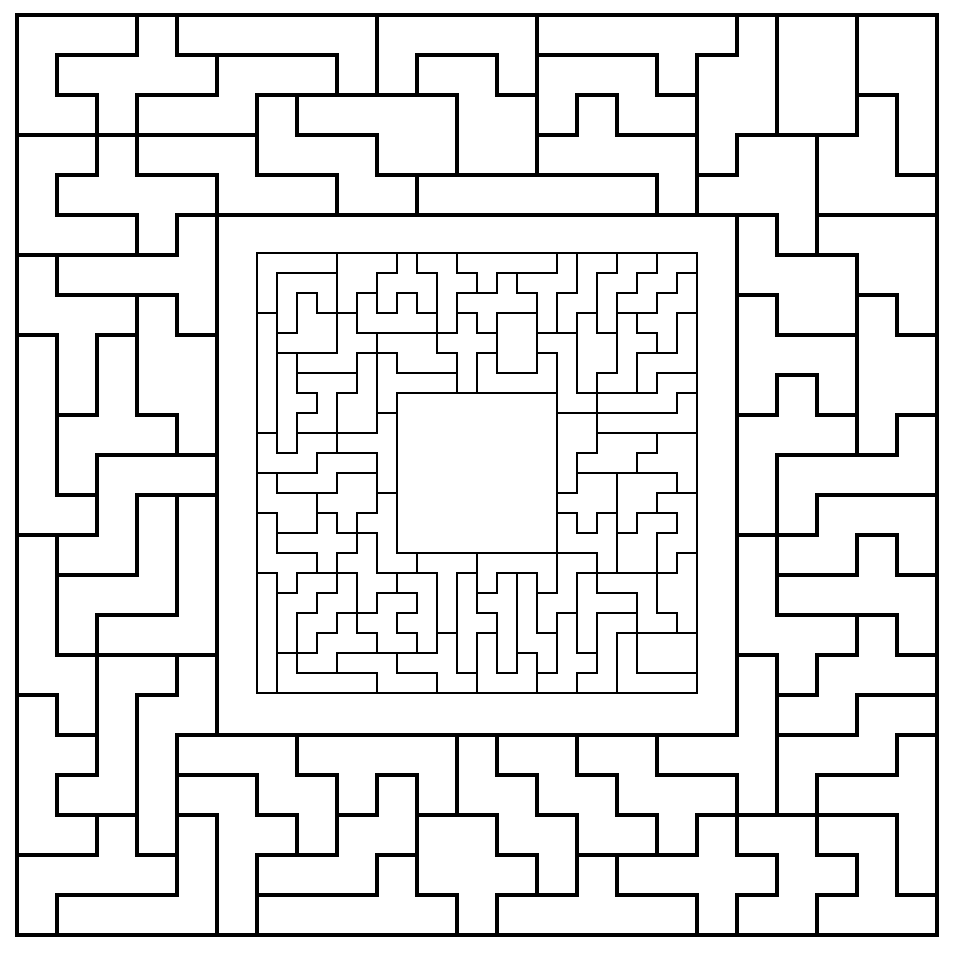
Square Doughnuts
Another shape which I like even better than the rectangle is
a square
with a smaller square removed. This resembles a large square
doughnut [52]. Above
is part of the original
cover of WGR6, showing doughnuts made
with a one-sided set
(large) and a double set (small). The one-sided set doughnut is
23^2-13^2 ; the double set doughnut is 22^2-8^2 . Doughnuts
21^2-9^2 and 19^2-1^2 (not much of a hole!) are also possible
with a one-sided set; 26^2-16^2 is also possible with a double set
(Frans Hansson sent out a Christmas card in 1953 with a completely
symmetric solution, with only the two I's and U's shared between the
two halves). [Hansson also made a symmetric construction,
38^2-28^2, with a checkered set of 110 pieces (each asymmetric piece has four
versions, each reflection having two opposite checkering patterns):
this can be seen in Chessics 2:28 (see Bibliography).]
In addition to simply solving various rectangles and doughnuts with
one-sided or double sets, you can try connecting as many pairs as
possible [53]. The large doughnut above has nine pairs of
mirror image pieces (BfJKmNuWz) connected along at least one edge (if
you are using a double set, the pairs of identical pieces need not be
mirror images, though it is perhaps more elegant to do so).
Another problem to try with a double set is to
divide the area to be solved into two sections (equal in area but not
necessarily in shape) and solve each section with one full set
[54]. This was done with the small doughnut; can you
divide it into two pieces so that each piece contains 35 different
hexominoes? (See the Solutions section)
Pairing pieces suggests another problem I call the Nebula Problem
[55]. Use a double set to form a figure in which all 35 pairs of
identical pieces are connected (asymmetric pieces must be in
mirror-image pairs, but they may be oriented and connected in any way
desired). What is the smallest rectangle in
which such a figure can be enclosed? My best result so far is
21x24. I
doubt a perfect rectangle such as 20x21 is possible, though George
Sicherman has solved the corresponding problem for pentominoes, making
a 12x10 rectangle with 12 linked pairs.
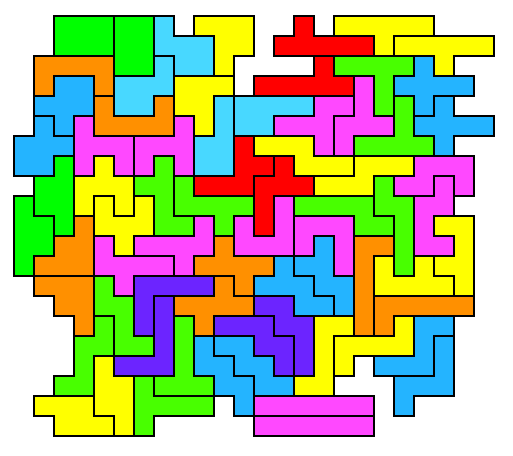
Nebula
Farms
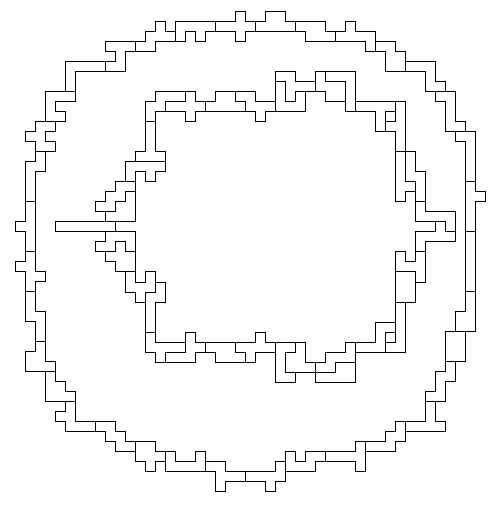
If we want to make perfect rectangles, we need more (or less) than the
full set of 35 hexominoes. But there are other things we can do. Many
pentomino puzzles involve farms: unbroken enclosures around an area,
often of some particular size or shape. We can do the same with
hexominoes. With an unrestricted shape, I enclosed 1578 units with
an asymmetric (roughly circular) shape. Teun Spaans and
Rodolfo Kurchan observed that this could be improved to 1584 by
rotating three pieces (CHP) 180 degrees. I enclosed 584 units
with a bilaterally symmetric figure (which barely fits inside the
larger farm). These are shown above at half
scale. But perfectly square farms have also been studied
for both pentominoes and hexominoes:
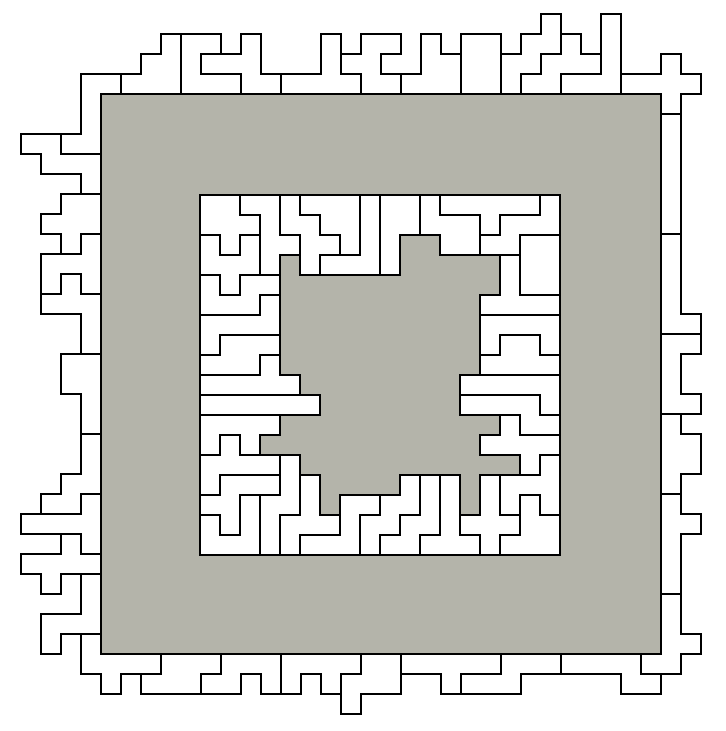
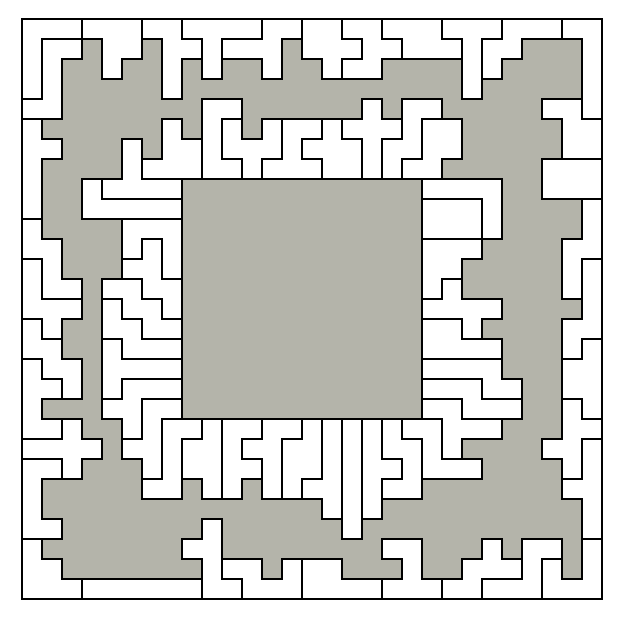
[56] Arrange the 35 hexominoes to form a square farm so that every
piece touches the outside (square) border. The farm may surround
an area of any shape, though all internal squares must be connected
into one whole. The largest square possible is 29x29 (above right, outside); I believe
the smallest is 18x18 (above left, inside), first discovered by Kate Jones (she wonders if
17x17 is possible; I do not think it is.)
[57] Arrange the 35 hexominoes to form a farm around a square, so that
every piece touches the inside square. The outside may be of any
shape, though no holes other than the internal square are
allowed. The largest square is 28x28 (above left, outside); the smallest is
probably 12x12 (above right, inside).
Internal Holes
Still another way to make rectangles with a full set of 35 is to allow
internal holes.
[58] Make a rectangle of any size with the full set of 35 hexominoes
with any number of internal 1x1 holes (I call this category of internal
hole problem Swiss problems, as the solutions resemble a large piece of
Swiss cheese). The holes must be solidly
enclosed; they may not touch the outside of the rectangle or other
holes, even corner to corner. Holes larger than 1x1 are
disallowed as well (but see Waffle problems below, beginning with
[64]). The size of the rectangle determines how many
holes you need. For example, 18 holes gives an area of 228,
giving a rectangle of 12x19. My first decent
attempt was 17x14 with 28 holes; my best was 32 holes
(22x11). P. J. Torbijn and Jean Meeus examined this
problem in the Journal of
Recreational Mathematics
(see Bibliography). They proved that the maximum number of holes
possible in a rectangle is 50, though they were unable to construct a
rectangle with 50 holes. Patrick Hamlyn later managed to
find a 13x10 rectangle with 50 holes (reproduced from Andrew
Clarke's Polyomino Pages, below left). Rodolfo Marcelo Kurchan constructed a rectangle with 42 holes arranged symmetrically (Puzzle Fun 23, Problem 264, page 3).
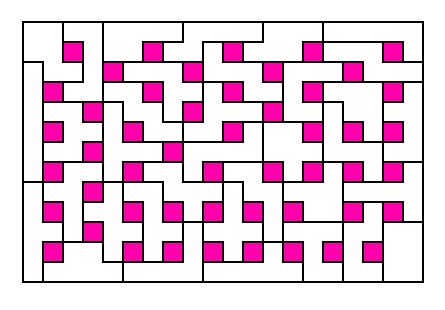
50 internal
1x1
holes (Patrick Hamlyn)
Instead of 1x1 holes, use tromino holes, either straight [59] or
right-angled [60]. [Mixing them is possible too]. Again, the holes may not touch the outside or
each other, even at corners. My best efforts were 10 right trominoes (15x16) and 14
straight trominoes (18x14). Rodolfo Marcelo Kurchan improved both: Puzzle Fun 23 shows a remarkable 18x15 rectangle with 20 straight trominoes arranged symmetrically (problem 272, page 4). Problem 275 shows 22 right trominoes.
If the outer shape need not be rectangular, a larger number of holes is
possible. Below is a 52-hole solution, by Dominique Mallet (from
Andrew
Clarke's pages again). This may not be the maximum:
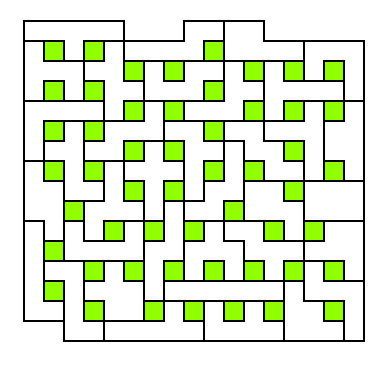
[61] What about domino holes? We cannot make a rectangle with
the
full set of 35 (the same parity problem exists), but it makes a good
problem anyway. Discard one unequal hexomino, and enclose as many
dominoes as possible with the remaining 34. My best is 15
dominoes (18x13). With any outer shape, my best is 35
dominoes, which appeared on the back cover of WGR11. Rodolfo
Marcel Kurchan constructed a figure with 28 domino holes (Puzzle Fun 23, problem 266, page 4) , with both the outer shape and the interior holes symmetric.
[62] Next try one hole each of progressively increasing sizes (any
shape): one monomino, one domino, one tromino, etc. As usual the
holes may not touch each other. I managed 12
holes of sizes 1 through 12 in a 16x18 rectangle; Michael Reid improved
this to 15 holes in a 15x22 rectangle (see Appendix).
15 is almost certainly the maximum: 16 would be an impossible 2x173
rectangle, and there does not appear to be enough resources to surround
two more large areas of 16 and 17 in an 11x33 rectangle.
[63] Make a 15x16 rectangle containing four square holes of different
sizes: 1x1, 2x2, 3x3, and 4x4. My original solution is
shown below. Later I made an expanded version with square
holes up to 7x7, in a 25x14 rectangle. This eventually
became the full-color logo for Puzzle Laboratory (see the beginning of
this booklet).
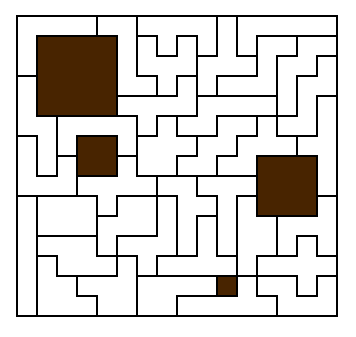
Waffle Problems
Internal square holes can also be arranged in a regular grid,
dropping the requirement that the outer shape be rectangular.
Every piece must touch at least one hole along at least one edge.
I call this The Waffle Problem, since the solution looks like a big
(though irregular) waffle. My best effort with 1x1 holes [64], 33
holes, is shown below. The 1x1 holes can also be separated
by two thicknesses [65], or the holes can be 2x2, separated by either
one thickness [66] or two [67] (see examples below). I managed 21 1x1 holes with a separation of two, 17 2x2 holes
with a separation of one and 14 holes with a separation of
two. [In their JRM article, Torbijn and Meeus show a square
Waffle, a 15x15 square with the holes arranged in a perfect 3x5 array.]
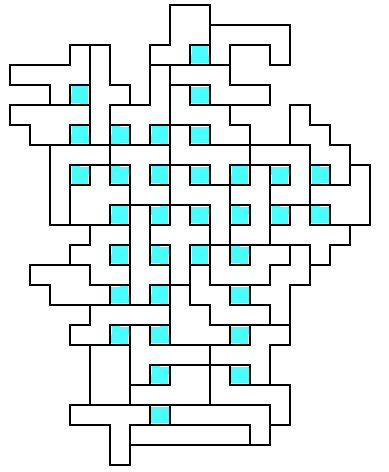
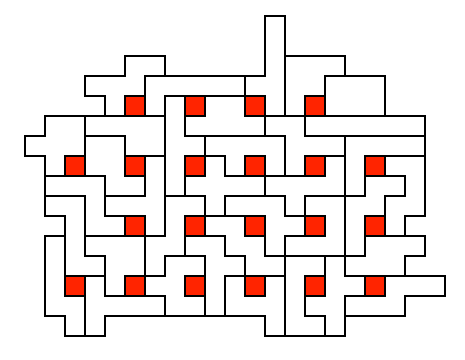
The Waffle
Problem
[65]
1x1 hole
pattern
[64]
33 holes on a regular
grid
separation
2 (21 holes)
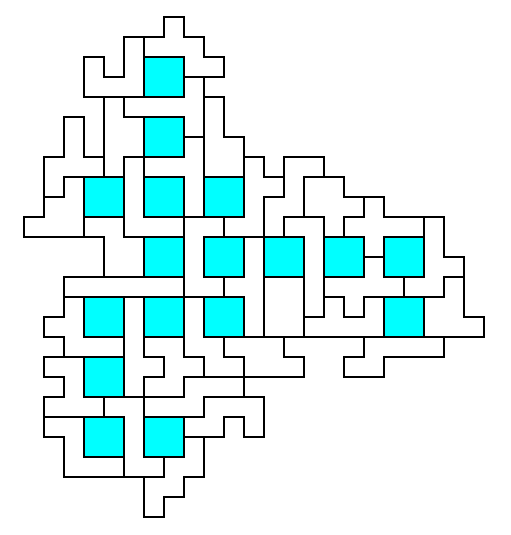
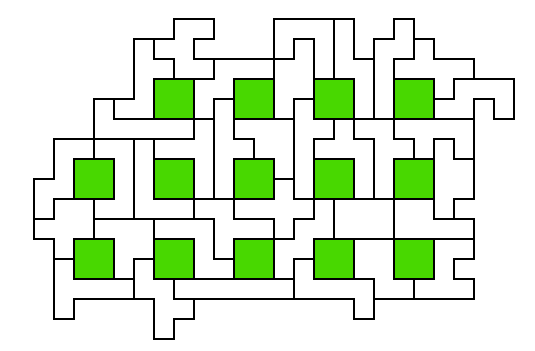
2x2
hole patterns
[66]
separation 1 (17 holes)
[67]
separation 2 (14 holes)
Full set puzzles: Tabbed
Rectangles
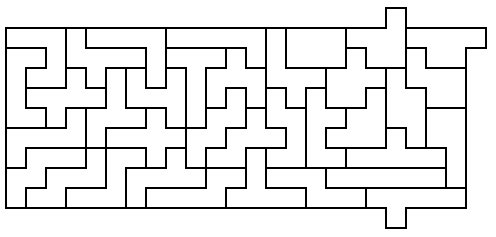
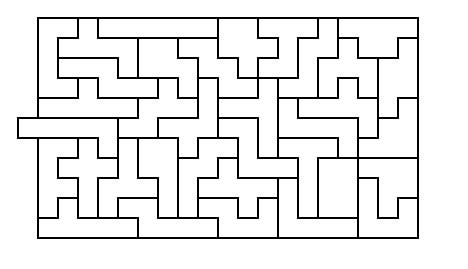
9x23 rectangle with 3 tabs
[70]
11x19 rectangle with 1 tab [68]
(What's unusual about this
solution?)
Instead of adding internal holes to create rectangles greater than 210
units in area, we can also form rectangles less than 210 units in area,
with extra squares on the outside (called tabs). The Japanese
puzzle manufacturer Tenyo puts out a hexomino set, in its series Beat
The Computer, in the form of an
11x19 rectangle with a single extra square in the middle of the long
side. There are 7 other locations [68] for a single tab on an
11x19 rectangle. More than one tab can also be used; for example,
a rectangle 4x52 with two tabs can be formed. Do not make tabs
more than one square in size or place them adjacent to other
tabs. An example of a three tab rectangle (9x23) and a one tab
rectangle are shown above (the 11x19 solution shown
has an interesting feature: can you spot it?). Some
of the
possible tabbed rectangles which can be
made are:
Table 6: Tabbed rectangles made by adding external squares
Number of Tabs Area of main rectangle Rectangles
possible
[68]
1
209
11x19 (8 tab locations)
[69]
2
208
4x52, 8x26, 13x16
[70]
3
207
9x23
[71]
5
205
5x41
[72]
6
204
4x51, 6x34, 12x17
[73]
7
203
7x29
[74]
10
200
4x50, 5x40, 8x25, 10x20
[75]
12
198
3x66, 6x33, 9x22, 11x18
[76]
14
196
14x14, etc.
Is 3x66 the best tabbed 3xn rectangle possible?
The Congruent Shapes (Layer)
Problem
It is well known that a 3x4 square can only be made in three ways with
the 35 hexominoes: Bu, OV, and pU. But what if we use a different
shape with an area of 12 squares? What figure can be solved the most
ways using distinct pieces? I like to call this the Layer Problem,
because the solutions to a given figure can be stacked one on top of
another to make a three-dimensional figure. The best solution I
have found for 2-piece figures is seven simultaneous layers, shown
below. The table lists the best known solutions for other numbers
of pieces; except for two and three pieces, all numbers of solutions
are known to be the best possible. For the larger numbers of
pieces, irregular shapes are more interesting to solve.
{In the
original supplement, we wrongly stated that parity prevents 5x7 and
7x5. It does not, but it is necessary for each layer to contain an odd number of
unequal hexominoes: e.g. 3+3+3+1+1 or 3+3+1+1+1+1+1.}
Table 7: Maximum solutions to the
Layer problem
[77] [78] [79] [80] [81] [82] [83] [84] [85] [86]
Number
of Pieces 2
3 4 5
6 7 8
9 10 11
Maximum
Layers 7 10
8 7
5 5 4
3 3 3

7
layers of 2 pieces
[77]

10 layers
of 3 pieces [78]: first published on the cover of WGR11

7 layers of 5 pieces [80]

5 layers of 7 pieces [82]
Ornamental and Geometric Figures
Except for [87], which uses only 33 pieces, all of the
figures below use the full set of 35 hexominoes. [89] is a
well-known problem. Len Gordon's solution, with 1024 variants, is
shown in the Appendix.
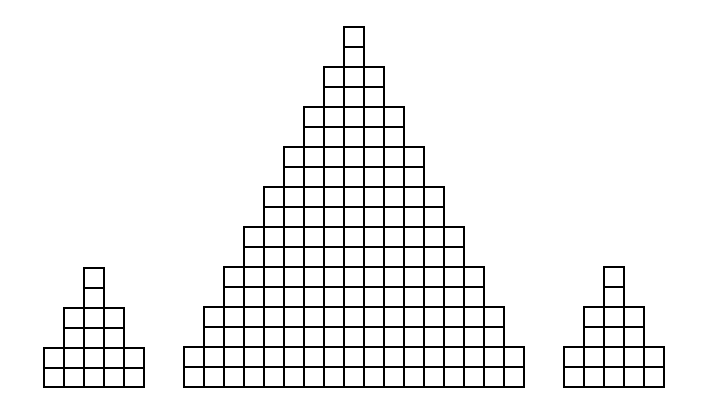
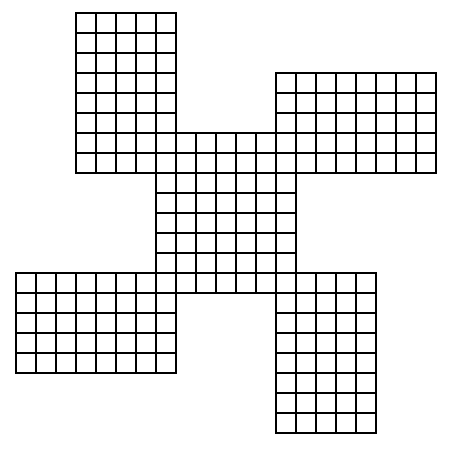
[87] Christmas Tree
Triptych
{33}
[88]
Windmill
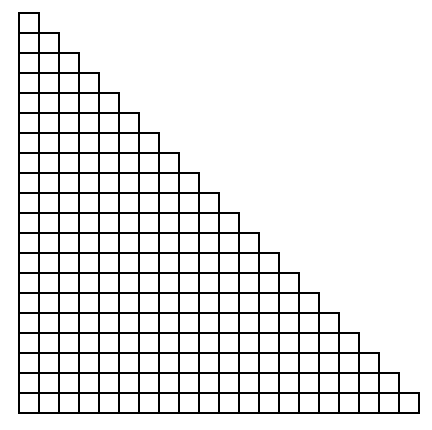
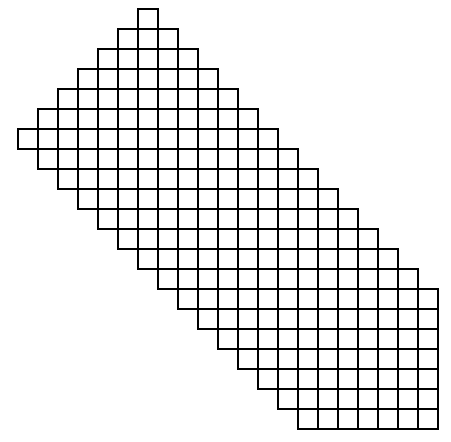
[89]
Isosceles Right
Triangle
[90]
Pentagon
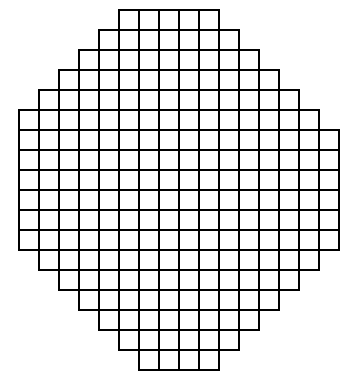
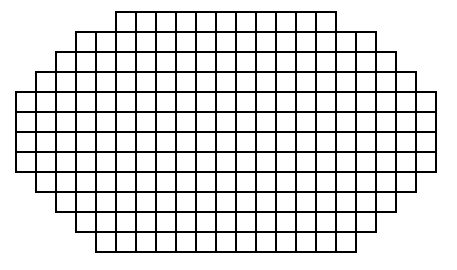
[91]
Octagon
[92]
Oval
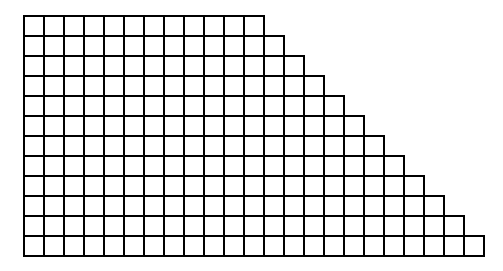
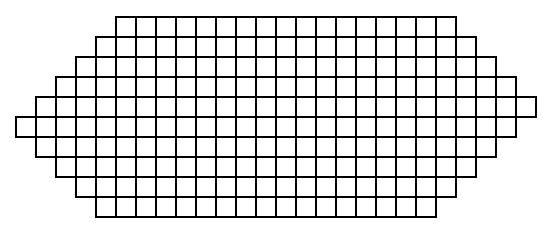
[93]
Trapezoid
[94] Hexagon
Layer Multiplication Problems
Inspired by a construction sent to me by Teun Spaans, here are some
additional problems, which first appeared in the polyform omnibus issue
WGR9 in December 1989. They all involve making multiple
layers of a two- or three-piece shape, then duplicating or triplicating
the figure (or both) using most of the remaining pieces.
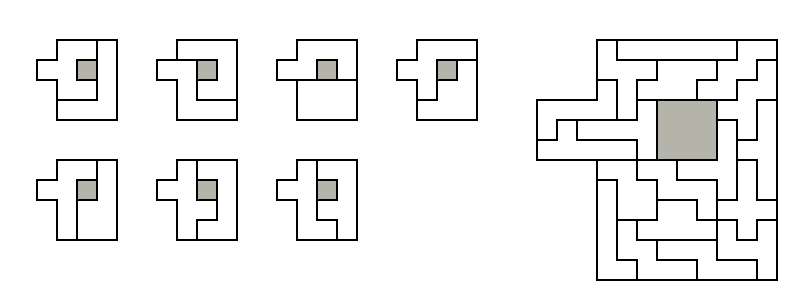
[95] Triplicated two-piece layers [32 pieces]: Seven identical
two-piece layers are triplicated using all but three of the remaining
pieces. [I don't know if eight layers of two pieces are
possible: if so, it may still be possible to triplicate the figure.]
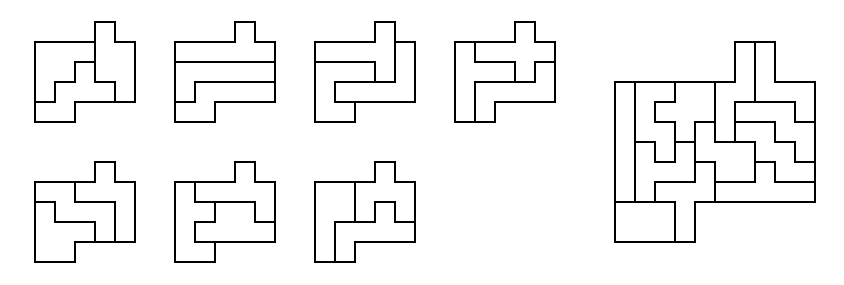
[96] Duplicated three-piece layers [33 pieces]: Seven identical
three-piece layers are duplicated using all but two of the remaining
pieces.
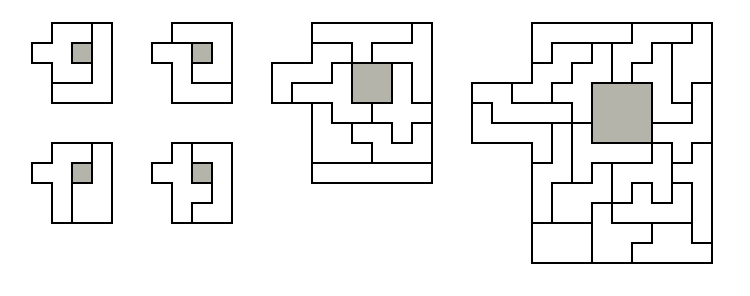
[97] Duplicated and triplicated two-piece layers [34 pieces]: Four
identical two-piece layers are both duplicated and triplicated.
Full Set Multiplications
[98] One-Three-Five (first solved in 1946 by Frans Hansson): Choose any
unequal hexomino and use 9 other
hexominoes to triplicate it, then use the remaining 25 to quintuplicate
it. This has the advantage of being more challenging than
problems [5] through [10], but the disadvantage of having only 11
variations, since checkerboarding rules out the use of a 3-3 hexomino
as the single piece. Still, it ranks among the most elegant
full-set problems. All eleven problems are possible; here is one
example:
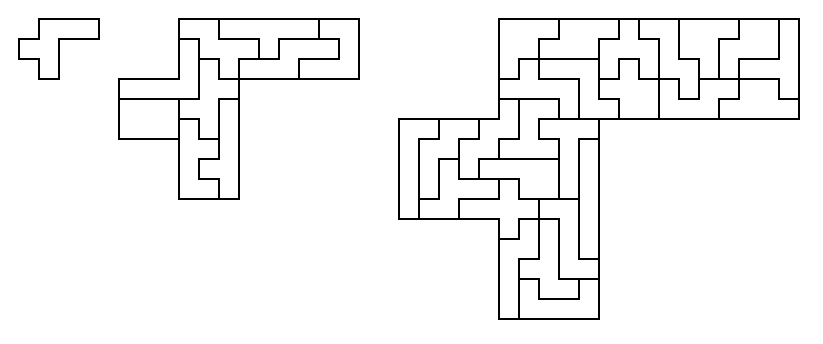
[99] The unequal hexominoes can also be multiplied in an unusual way,
by
converting each square to a 5x7 rectangle. In this instance
you will need to use the piece being multipled in its own replication (or
you can place it in the interior and think of it as a hole the same
shape as the piece being replicated). For a more elegant
solution, try to place the piece in the same orientation as the
original. This puzzle has 20 variations, as the nine asymmetric
pieces produce different puzzles depending on how the 5x7 rectangle is
oriented (M and x each only have one version). Here is an
example with one orientation of the w hexomino:
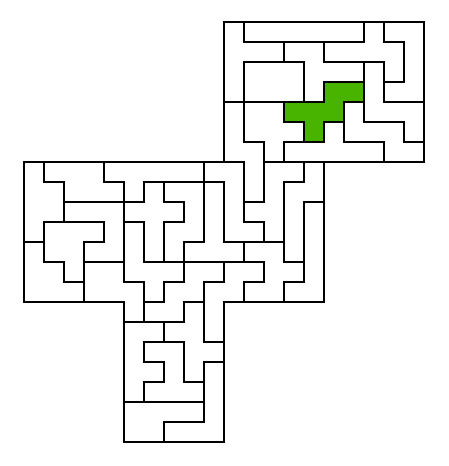
[100] Hexomino Solitaire (after Henri Picciotto)
In his book Pentomino Lessons (page 18), Henri Picciotto describes
Pentomino Solitaire. Two pentominoes are combined to make a
figure, which is duplicated by two other pentominoes. These two
are then rearranged to form a new figure, which is duplicated by two
more
pieces, etc. The object is to form a chain (closed or open)
as short as possible, containing all 12 pieces (with pieces allowed to
be used more than once). Richard I. Hess found three closed
chains of length 7 (e.g. IL-TY-LZ-PV-UX-FP-WN-IL). These all have
the slight aesthetic flaw that the pieces are not always
rearranged.
I have tried a similar problem with hexominoes, but instead of
trying
to use every piece, I have tried to construct the longest open chain or
closed loop without reusing a piece. My best result is a closed
loop of 15 pairs, shown below left. I also accidentally came
across two loops of only four pieces, shown in detail below right to
illustrate the process used in solitaire (note that both include the pair fw).

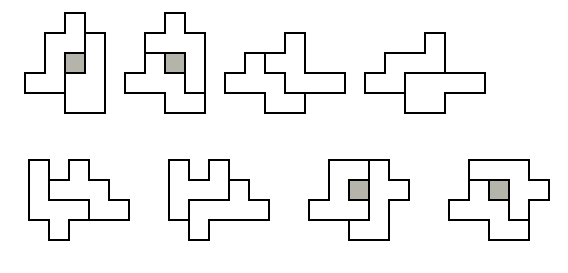
15-pair loop (30 pieces)
2-pair loops
[101] Non-Symmetric Equivalences (after David Singmaster)
David Singmaster (of Rubik's Cube fame) studied pentomino figures in
which the same shape can be made in two or more different ways (not
counting reflections) with two, three, or four pieces. He calls these non-symmetric equivalences. This problem was reported in Sivy Farhi's booklet Pentominoes,
and David was kind enough to send me his set of solutions (2 two-piece,
18 three-piece, and 22 four-piece) found by examining solutions to
pentomino problems. In WGR7 we ran a cash contest (Contest Seven)
with a $100 prize fund, asking for two-piece non-symmetric equivalences
with any polyform type. It turned out they are much more
common than I suspected: Leonard Gordon sent in more than 100 and
collected most of the prize fund (Anneke Treep and P.J. Torbijn also
sent a few). The diagram below shows
Singmaster's two 2-piece pentomino
solutions (the first is well known, as it occurs in the 2x5x6 rectangle
problem), along with three hexomino figures I discovered before the
contest, and another found by Gordon. [These can be considered
1-pair loops in Polyomino Solitaire.]

Singmaster
Singmaster
Gordon
[102] Butterflies
Construct simultaneous bilaterally symmetric figures of 2 through 8
pieces using the full set of 35 hexominoes.

[103] Symmetric Pairs
Construct 17 simultaneous bilaterally symmetric figures of 2 pieces with one symmetric piece left over, using the full set.
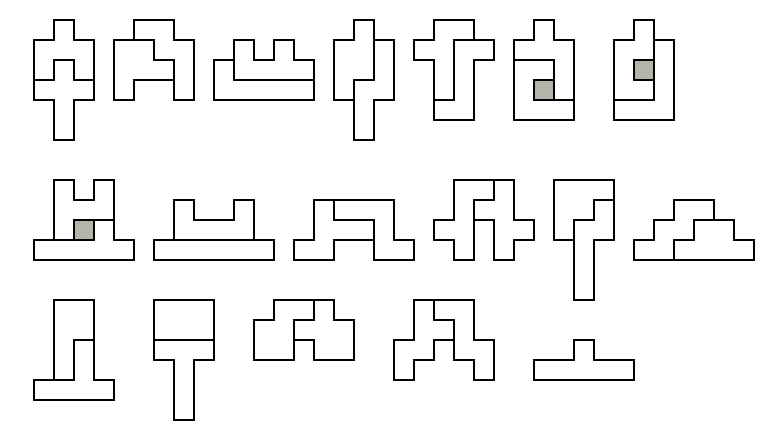
[104] Symmetric Trios
Construct 11 simultaneous bilaterally symmetric figures of 3 pieces and one symmetric figure of two pieces, using the full set.
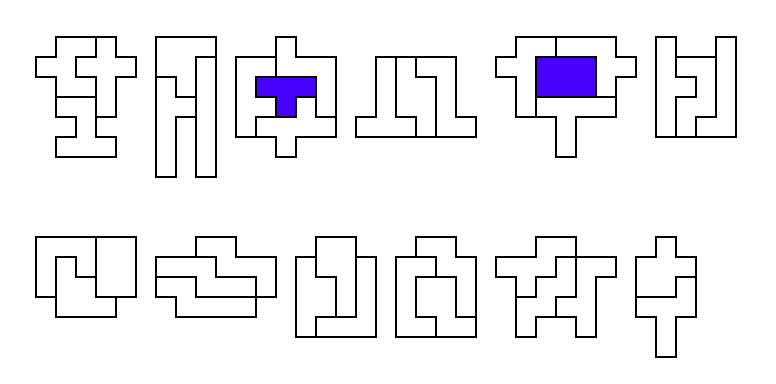
More subsets
[105] All pieces that fit in a rectangle two units wide (CDGILNnOPpUYy) can form a 2x42 rectangle:

[106] Inflated Hexominoes
It is possible to construct rectangles (particularly perfect squares)
using a mixture of polyominoes of different scales, but from the same
set. Rodolfo Marcelo Kurchan first examined this variation in 1994
in the first issue of his magazine Puzzle Fun
(now available online) He showed a number of constructions using
the 12 pentominoes at different scales. In 2017, Puzzle Fun 27 showed several hexomino constuctions by Edo Timmermans and Livio Zucca. Puzzle Fun 36 shows a construction by Roel Huisman which is a 183750 x 183750 square using progressively larger-scaled pieces. In
the figure below left I used the first scheme by
Timmermans: a 32-1-2 pattern with 32 normal sized hexominoes, 1
double-scaled piece (this must be an unequal hexomino), and two
triple-scaled pieces (these must be either both equal, or [as shown
below] both unequal). This makes an 18x18 square, which
seems to be the smallest possible. The figure below
right is the smallest possible rectangle, 19x12, using one doubled
(unequal) piece.
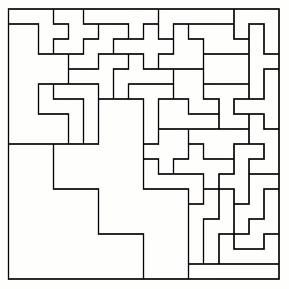
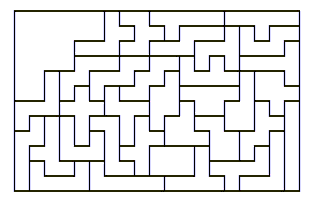
[107] The Narrow Passage Problem
Anneke Treep posed the following problem in Ideaal,
bulletin of the Math Department of the University of Twente: Using the
twelve pentominoes, construct an interior hole which is no more than
one unit square wide at any point (i.e. a single path of squares with
no branches). When the problem was published in The Journal of Recreational Mathematics,
the best result (found by Anneke and two other solvers) was 40
units. As originally stated, the path was allowed to touch itself
at diagonals. The Life of Games later ran a contest
for the longest narrow path with hexominoes, specifying that the hole
be solidly surrounded. Aad van de Wetering won the contest
with a passage of 146 units
which I believe is still the record. A number of solutions
for various polyform sets appeared in WGR11 (pp. 12-13, and both
covers) in June 1992.
Appendix: Additional Solutions

Minimal solution to [2] with five pieces

[9] Double Double Triple, using nine unequal pieces to form the
base figure

[12] and [21] I-derivatives (2x13) and
Z-derivatives (5x7) by Robin King

[22] Di-orthotrominoes (3x11) by George
Sicherman, [37] Symmetric (4x15) by David Bird,
and [39] Symmetric or Rotational (6x15) by George Sicherman

[13]
L-derivatives
[42] N-less hexominoes
perfect 6x11 by Michael Reid
perfect
9x10 and 6x15 by Michael Reid
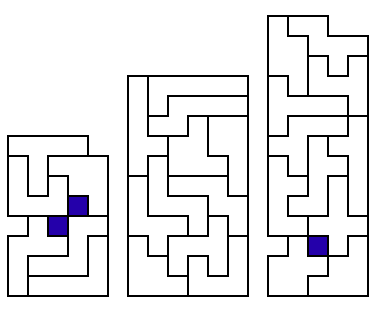
[18]
5x8 [24]
6x11 [29] 5x14
Sergio Stanzani subset rectangles
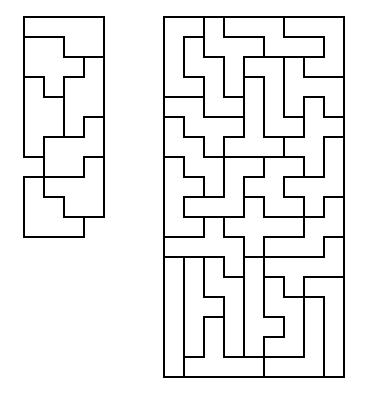
Perimeter 12 and 14
[31] [32]

Symmetric Swiss (31) by Teun Spaans: the pieces and holes are arranged with bilateral symmetry
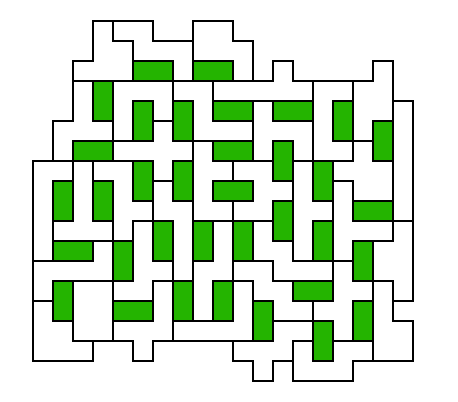
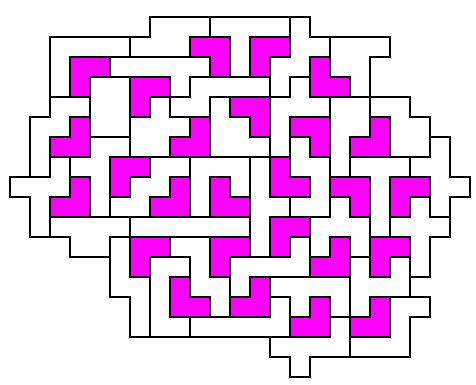
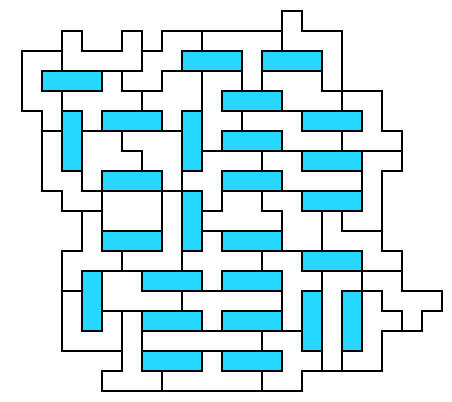
Swiss Dominoes
(35)
Swiss V
Trominoes (26)
Swiss I Trominoes (26)
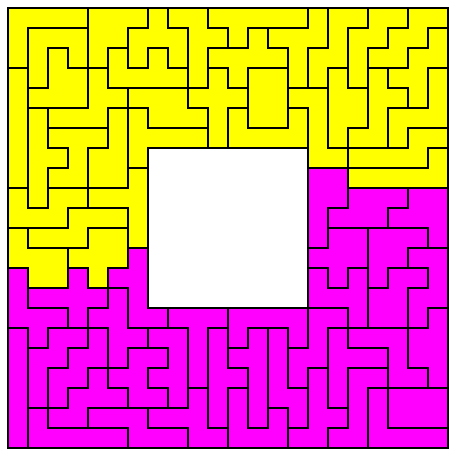
[52] Square Doughnut divided into 2 sets
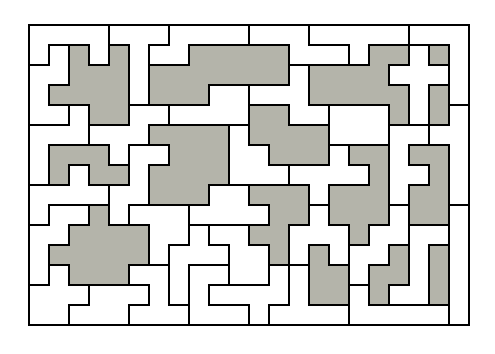
[62] Michael Reid's 15 progressive holes in a 15x22 rectangle
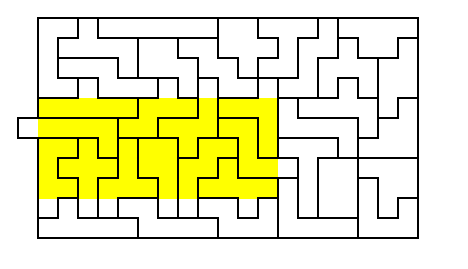
Hidden
5x12 solution in [68]
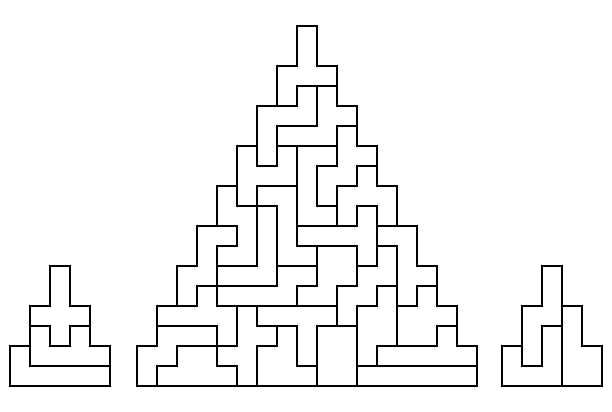
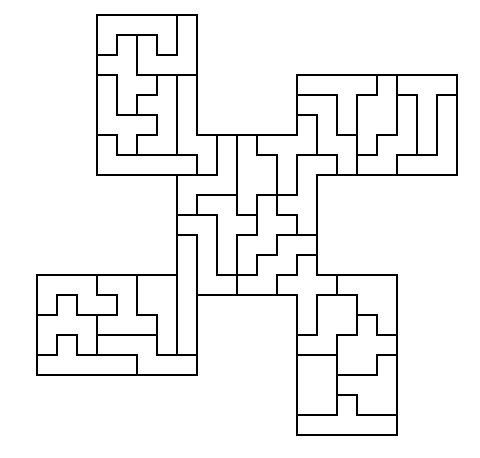
[87] Christmas Tree Triptych
[88]
Windmill
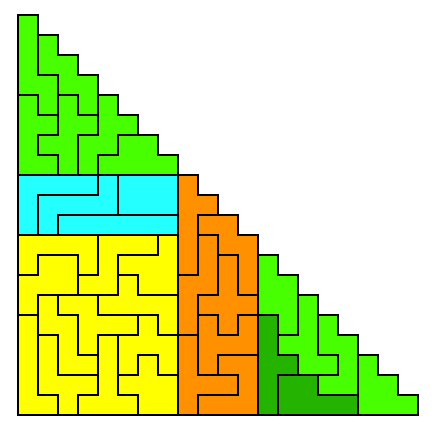
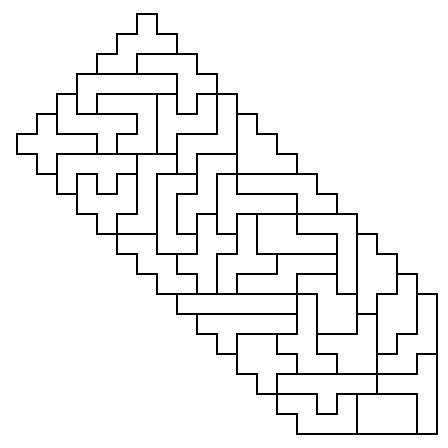
[89]
Isosceles Right Triangle
[90]
Pentagon
Len Gordon's 1024 solutions
(first published on the cover of
WGR13)
Len Gordon's solution to the Isosceles Right Triangle, first
published in WGR9, can be modified by reflections, rotations, and
exchanges of the colored regions to produce 1024 different solutions.
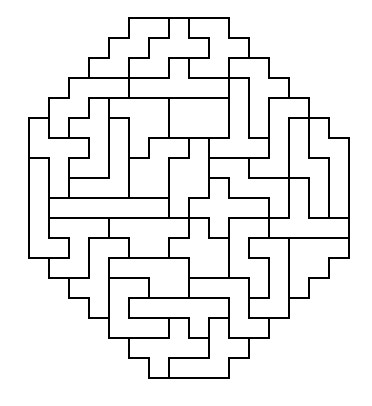
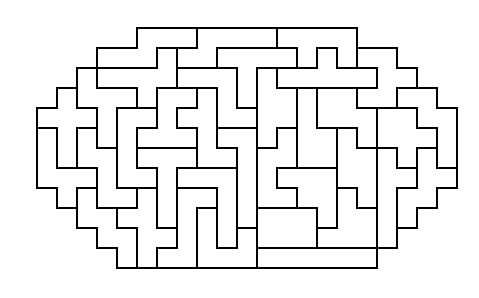
[91]
Octagon
[92] Oval
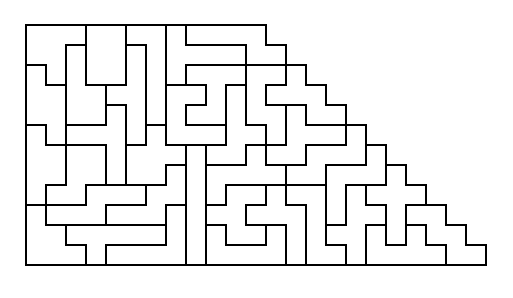
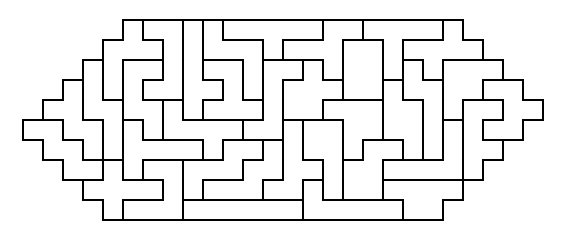
[93]
Trapezoid
[94] Hexagon
Bibliography
Far less has been written about hexominoes than their smaller cousins,
pentominoes.
Hexominoes
Clarke, Andrew L., Isoperimetrical Polyominoes, Journal of
Recreational Mathematics, Vol. 13, Num. 1, pp. 18-25, 1980,
Baywood
Publishing Co.
(Page 58 also contains a diagram of all of the 164
polyominoes of orders one through seven, illustrating a problem by Hans
Havermann: arrange them into a 5x211 rectangle.)
Coffin, Stewart, Puzzle Craft, 1985, Stewart T. Coffin, 79
Old Sudbury Road, Lincoln, MA 01773.
More detail on the Cornucopia Puzzle.
Dewdney, A. K., Computer Recreations, Scientific American, October
1985, pp. 16-27.
Gardner, Martin, The Scientific American Book of
Mathematical Puzzles
and Diversions, 1959, Simon and Schuster, pp. 135-140
Latter portion of Chapter 13, Polyominoes (originally
published in Gardner's Mathematical Games column, Scientific
American, 227:176-182, September 1972).
Gardner, Martin, Mathematical Magic Show, 1990, The Mathematical
Association of America, pp. 183-187.
Latter portion of Chapter 13, Polyominoes and
Rectification.
Golomb, Solomon W., Polyominoes, 1965, Charles Scribner's Sons,
182pp., hardback
Havermann, Hans, N-Omino Packing, Problem 929, Journal of
Recreational Mathematics, Volume 13, Number 1, 1980, pp. 57-58
(solution V.14, Num. 1, pp. 69-70)
Jelliss, G.P., Special Issue on Chessboard Dissections, Chessics, Vol. 2, Num. 28, Winter 1986
Material on polyominoes from Fairy Chess Review (decoded
by Jelliss from a special notation used in place of expensive diagrams)
and the unpublished notebooks of Walter Stead. Hexominoes
are covered on pp. 144-145, and mixed sets on p. 146.
Kadon Enterprises, Sextillions, 1984, Kadon Enterprises
Laatsch, Richard G., Rectangles from Mixed Polyomino Sets, Journal of
Recreational Mathematics, Volume 13, Number 3, 1981, pp. 183-187.
Pages 185-186 discuss the set of hexominoes plus trominoes, and show a
12x18 rectangle.
Nelson, Harry L., Hexomino Packing, Problem 1064, Journal of
Recreational Mathematics, Volume 14, Number 2, 1981, p. 138
(solution
V.15, Num.2, p. 145)
Philpott, Wade E., Polyomino and Polyiamond Problems, Part I, Journal of
Recreational Mathematics, Volume 10, Number 1, 1977-78, pp. 2-14
Pages 12-14 show the hexominoes and give one solution to
sextuplication of an unequal hexomino (C) with that piece used twice.
Torbijn, P.J., and Jean Meeus, Hexominoes in Rectangles, Journal of
Recreational Mathematics, Volume 19, Number 4, 1987, pp. 254-260
Examining the Swiss rectangle problem, proving that 50 holes is the
maximum possible, though they did not manage to find a solution (later
solved by Patrick Hamlyn). They show a number of solutions,
including a 15x15 square with 15 holes arranged in a symmetric 3x5 grid
(as in the Waffle Problem), and a 16x16 square with 46 holes, the
best-known solution until Hamlyn.
Relevant Sources on other
Polyominoes
Farhi, Sivy, Pentominoes, 1981, Pentacube Puzzles
Klarner, David A., The Mathematical Gardner, 1981, Van Nostrand
Reinhold
Kurchan, Rodolfo Marcelo, Puzzle Fun, 1994-present
Primarily devoted to pentomino constructions, but constructions for hexominoes and other sets appear frequently.
Martin, George E., Polyominoes, a Guide to Puzzles and
Problems in
Tiling, 1991, Mathematical Association of America, 184pp., paperback,
ISBN 0-88385-501-1
Treep, Anneke -- The Narrow Passage Problem, Number 1739, Journal
of Recreational Mathematics, Volume 21, Number 3, 1989, page 220.
[Solutions in Vol. 22, Num. 3, pp. 237-238.]
This compilation of WGR was published on January 7,
2024. Most of the diagrams were made using a new drawing
module
written for Puzzle Virtuoso. Roel Huisman submitted diagrams for his own solutions.
This article is
copyright ©
2024 by Michael Keller. All rights reserved.

















































































